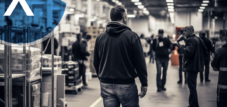Published on: May 16, 2025 / update from: May 16, 2025 - Author: Konrad Wolfenstein
Current developments at Intersport Austria, Wildboer and through the partnership of Robotize & Roeq
The intralogistics is in change
Companies are increasingly relying on fully automated systems and robotics to increase efficiency, flexibility and competitiveness. The current projects of Intersport Austria and Wildboer as well as the partnership between Robotize and Roeq illustrate this trend.
Suitable for:
Intersport Austria: Highly automated distribution center with robotics
Project scope
Intersport Austria has extensively expanded its distribution center in Wels and equipped with a highly automated intralogistics system from TGW Logistics. The aim is to bring several smaller camps together in a central, automated location and thus significantly increase performance, capacity and flexibility.
Technical highlights
- Four-grassy shuttle system with triple-deep storage for maximum storage density (122,000 containers/boxes).
- Six high-performance commissioning workplaces, including a "Rovoflex" picking robot based on AI.
- Fully automated shipping cardboard direction and closure.
- TGW Warehouse Management System (WMS): controls and monitors all processes, is connected to the ERP system.
To use
Automation enables daily, needs -based delivery of the sales outlets, accelerates deliveries and reduces sources of error. Employees are relieved of repetitive tasks and can concentrate on value -adding activities.
Wildboer: Fully automatic intralogistics with mobile robots
Project goal
Wildeboer Bauteile GmbH, together with Jungheinrich and MHP, has built a new logistics center in Weener, which relies on fully automated intralogistics in order to expand storage capacities and shorten through.
Technical implementation
- Mobile Robots: Six ERC 213a take over the transport of large-scale charging carriers (pallets, grid boxes), the Soto robot transports small charging carriers (KLT) along the production line.
- Management-independent fleet management (MHP-Fleetexecuter): controls various robot types centrally and enables the integration of new vehicles via VDA 5050 interface.
- Performance data: over 83 pallet and 22 KLT transport per hour; Real-time material tracking and flexible adaptation to production cycles.
Advantages
The solution is scalable, sustainable and can react flexibly to changes. It increases productivity, reduces personnel deployment for monotonous activities and meets the shortage of skilled workers.
Robotize & Roeq: Partnership for flexible, scalable automation
cooperation
The Danish companies Robotize (AMR development) and Roeq (robot equipment) bundle their skills to offer companies comprehensive, safe and efficient automation solutions for internal material transport.
Technical innovations
- Combination of AMRS and modular essay solutions: The first common product is the Roeq TMC300 top module, which allows the Robotize Gopal P35 AMR to autonomously transport loads up to 300 kg with the Roeq Cart500.
- Easy integration and scalability: solutions are designed for various industries (production, warehouse, logistics) and can be implemented and expanded easily.
Market trend
The demand for flexible, modular transport solutions such as carts and trolleys is growing strongly. The partnership enables companies to make their intralogistics efficient, cost -saving and future -proof.
Suitable for:
Market development and meaning
growth
The market for logistics robotics grows with around 17 % annually and will probably reach a volume of $ 21 billion by 2029. 75 % of companies plan to automate at least one process in their supply chain by 2026.
Benefits of automation
- Increased efficiency and reduced costs
- Reduction and process reliability
- Employee relief and better working conditions
- Flexibility and future security
challenges
Investment costs, employee skepticism and a lack of automation concepts sometimes slow down the introduction, but concrete projects and studies show that the greatest potential in the area of picking and material transport are.
Robotics as standard: innovation and flexibility in intralogistics
The examples of Intersport Austria, Wildeboer and the Partnership of Robotize & Roeq show how fully automatic intralogistics and robotics already increase efficiency, flexibility and competitiveness. The integration of robotics-from picking robots to mobile robots to modular AMR solutions-is no longer a future topic, but becomes the new standard in logistics. Companies that rely on these technologies early on ensure decisive advantages in global competition.
Suitable for:
Your global marketing and business development partner
☑️ Our business language is English or German
☑️ NEW: Correspondence in your national language!
I would be happy to serve you and my team as a personal advisor.
You can contact me by filling out the contact form or simply call me on +49 89 89 674 804 (Munich) . My email address is: wolfenstein ∂ xpert.digital
I'm looking forward to our joint project.














